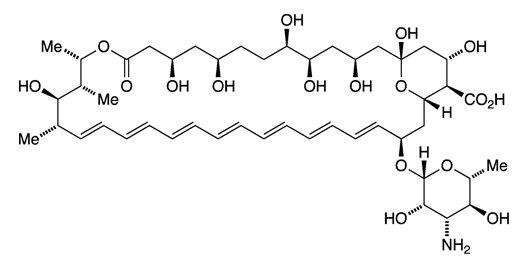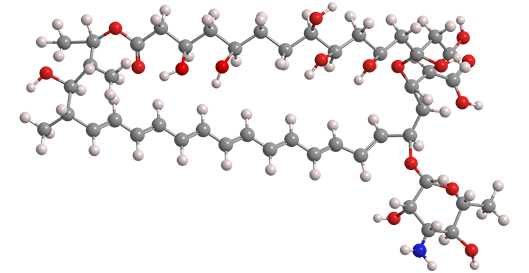What molecule am I?


Amphotericin B is an antifungal antibiotic produced by the bacterium Streptomyces nodosus. In 1955, it was isolated from soil collected near the Orinoco River of Venezuela by researchers at the Squibb Institute for Medical Research, now part of Bristol-Meyers Squibb (New Brunswick, NJ).
Carl P. Schaffner at Rutgers University (New Brunswick) and coauthors elucidated the complete structure and absolute configuration of amphotericin B in 1965. The molecule’s total synthesis was completed by K. C. Nicolaou, then at the University of Pennsylvania (Philadelphia) and co-workers in 1987. Until the 1980s, the compound was the only effective medication against systemic fungal diseases.
Now amphotericin B could have a new, important medical use. Martin D. Burke and colleagues at the University of Illinois at Urbana–Champaign showed that, when administered to cultured epithelial cells taken from the lung airway linings of cystic fibrosis patients, the drug created new ion channels to replace those blocked by mutations of the cystic fibrosis transmembrane conductance regulator (CFTR) protein. This procedure increased the pH and lowered the viscosity of the liquid secreted on the lining surfaces, resulting in improved bicarbonate ion flow.
The authors, together with cystic fibrosis researcher Michael J. Welsh at the University of Iowa (Iowa City), then treated pigs that lacked the CFTR protein with amphotericin B. Again, the pH of the airway surface liquid increased, showing that amphotericin B could be effective against cystic fibrosis when the CFTR protein is mutated or even absent. Clinical trials will follow.
Amphotericin B hazard information
| GHS classification*: not a hazardous substance or mixture |
*Globally Harmonized System of Classification and Labeling of Chemicals.
Amphotericin B fast facts
| CAS Reg. No. | 1397-89-3 |
| Empirical formula | C47H73NO17 |
| Molar mass | 924.09 g/mol |
| Appearance | Deep yellow prisms or needles |
| Melting point | >170 ºC (dec.) |
| Water solubility | 750 mg/L |

Learn more about this molecule from CAS, the most authoritative and comprehensive source for chemical information.
Molecule of the Week needs your suggestions!
If your favorite molecule is not in our archive, please send us a message. The molecule can be notable for its current or historical importance or for any quirky reason. Thank you!
Stay Ahead of the Chemistry Curve
Learn how ACS can help you stay ahead in the world of chemistry.

